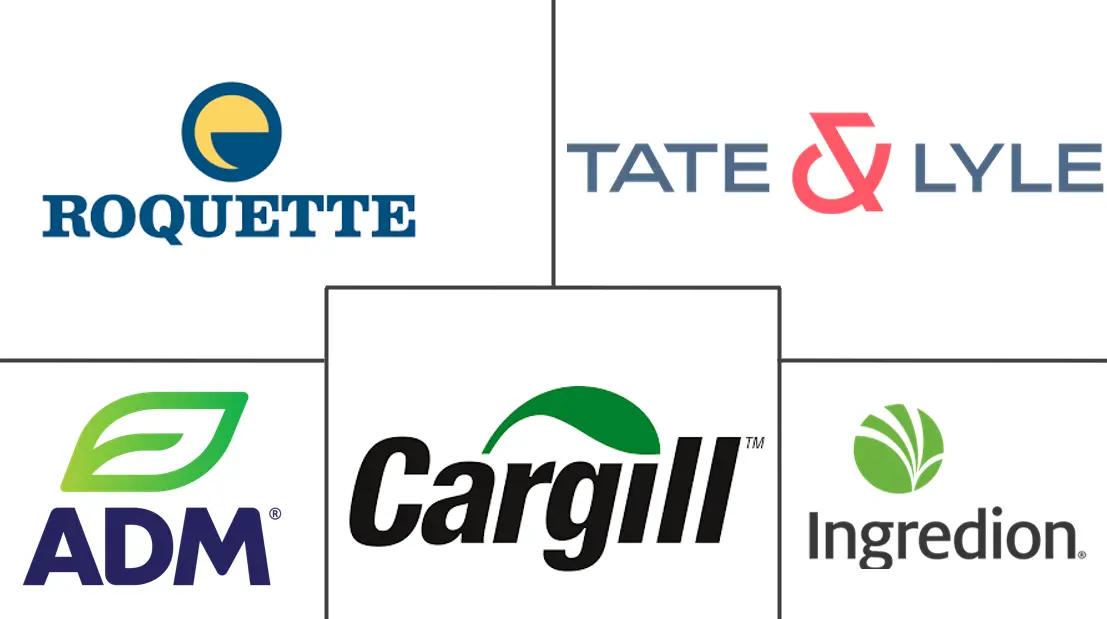Food Fibers Market Size and Share
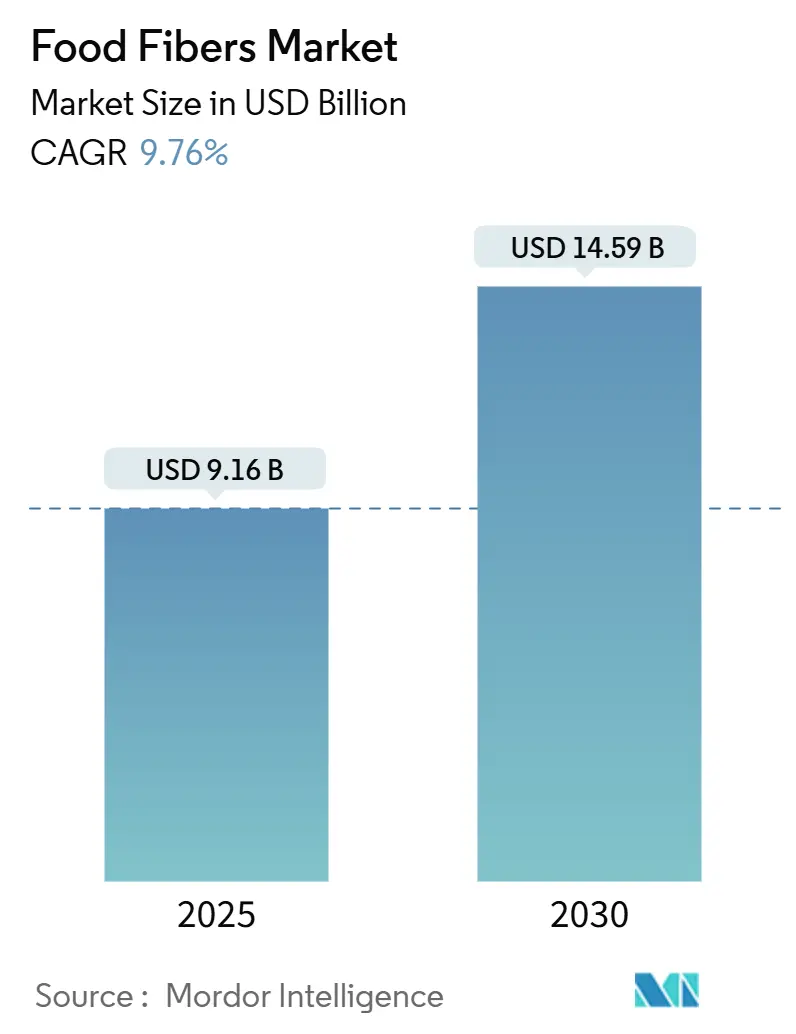
Food Fibers Market Analysis by Mordor Intelligence
The food fibers market, valued at USD 9.16 billion in 2025, is expected to reach USD 14.59 billion by 2030, growing at a CAGR of 9.76% during the forecast period. The market expansion is primarily driven by evolving regulatory frameworks, continuous technological advancements in fiber processing, and the increasing consumer emphasis on digestive health and wellness. The FDA's strategic inclusion of eight additional non-digestible carbohydrates, including inulin and resistant maltodextrin, in its dietary fiber definition has created substantial market opportunities for manufacturers and suppliers. Furthermore, China's comprehensive Food and Nutrition Development Guideline (2025-2030), which establishes a recommended daily fiber intake of 25-30 grams, demonstrates significant government commitment to improving population health while simultaneously stimulating market demand [1]Source: National Health Commission of the People's Republic of China," Guideline Aims to Promote Balanced Nutrition,"en.nhc.gov.cn.
Key Report Takeaways
- By type, soluble fibers led with 58.95% revenue share in 2024, whereas insoluble fibers are projected to post an 11.36% CAGR to 2030.
- By source, cereals and grains held 48.15% of the food fibers market share in 2024, while nuts and seeds are expected to advance at an 11.80% CAGR through 2030.
- By form, powders commanded 51.12% of the food fibers market size in 2024, yet liquid/syrup formats are forecast to grow at 12.05% CAGR between 2025 and 2030.
- By application, food and beverage accounted for 47.37% share of the food fibers market size in 2024; dietary supplements exhibit the fastest expansion at 12.64% CAGR to 2030.
- By geography, North America captured 41.24% of the food fibers market share in 2024, whereas Asia-Pacific is projected to grow at a 10.79% CAGR through 2030.
Global Food Fibers Market Trends and Insights
Driver Impact Analysis
| Driver | (~) % Impact on CAGR Forecast | Geography Relevance | Impact Timeline |
|---|---|---|---|
| Increasing prevalence of digestive disorders and obesity | +2.1% | Global, with higher impact in North America & Europe | Medium term (2-4 years) |
| Growing demand for functional and fortified foods | +1.8% | Global, led by Asia-Pacific and North America | Long term (≥ 4 years) |
| Increasing demand for fiber-rich foods and prebiotic fibers | +1.6% | Global, with early adoption in developed markets | Medium term (2-4 years) |
| Advancements in fiber extraction technologies | +1.4% | Global, with technology hubs in North America & Europe | Long term (≥ 4 years) |
| Growing demand for clean-label and natural food ingredients | +1.9% | Global, strongest in North America & Europe | Medium term (2-4 years) |
| Supportive government health campaigns | +1.2% | Asia-Pacific, North America, select European markets | Long term (≥ 4 years) |
| Source: Mordor Intelligence | |||
Increasing Prevalence of Digestive Disorders and Obesity
The rising prevalence of digestive disorders and obesity is transforming food formulation strategies in the industry. Global studies show that dietary fiber deficiency significantly contributes to disease burden, with low fiber intake leading to substantial ischemic heart disease deaths and disability-adjusted life years. In China, a considerable number of stroke deaths were associated with insufficient fiber consumption, demonstrating the need for dietary interventions. The economic impact extends beyond healthcare costs, as employers recognize that supporting digestive health through workplace nutrition programs improves productivity. This has increased B2B demand for fiber-enriched products in corporate catering and institutional food services, expanding beyond traditional retail channels.
Growing Demand for Functional and Fortified Foods
Growing consumer knowledge of nutrition is increasing the demand for foods offering specific health benefits beyond basic nutrition. The global functional foods market continues to expand as consumers seek products combining taste with health advantages. This trend is evident in product development that incorporates fiber, protein, and bioactive compounds to meet both flavor and wellness requirements. The FDA's recognition of additional dietary fibers has enabled manufacturers to develop more diverse product formulations with approved health claims. Companies are creating innovative cross-category products, including fiber-enriched snacks that serve as meal replacements, wellness bars with enhanced nutritional profiles, and beverages containing therapeutic levels of prebiotic fibers. This evolution in product development reflects the broader shift towards functional nutrition, where consumers increasingly prioritize foods that deliver targeted health benefits while maintaining appealing taste profiles.
Increasing Demand for Fiber-Rich Foods and Prebiotic Fibers
The gut-brain axis and microbiome has transformed prebiotic fibers from specialty supplements into widely adopted functional ingredients. Evidence shows that specific fibers, including resistant starch and inulin, can promote the growth of beneficial gut bacteria, resulting in improved metabolic outcomes in specific populations. The market is shifting toward personalized nutrition, as findings indicate that fiber benefits vary among individuals based on their gut microbiome composition. This variation drives demand for diverse fiber portfolios instead of single-ingredient products, as manufacturers aim to address different consumer responses. Companies are developing sophisticated multi-fiber blends and advanced delivery systems to ensure product effectiveness across broad consumer segments, while continuously exploring innovative formulation techniques to enhance bioavailability and functional benefits.
Advancements in Fiber Extraction Technologies
Technological innovation in fiber extraction is unlocking new raw material sources while improving yield efficiency and functional properties. Steam explosion technology has demonstrated the ability to increase soluble dietary fiber content in wheat bran from 9.82% to 16.72%, while maintaining nutritional integrity as per a literature on PubMed Central. Enzymatic processing methods, including the discovery of the CelOCE enzyme in Brazil, are revolutionizing cellulose conversion efficiency and potentially transforming agricultural waste into high-value fiber ingredients [2]Source: Phys.org, “Brazilian Researchers Identify CelOCE Enzyme,” phys.org. These advances are particularly significant for addressing supply chain constraints, as they enable the utilization of previously undervalued agricultural by-products. The technology is also improving the functional properties of extracted fibers, with subcritical water extraction methods producing fibers with enhanced antioxidant activity and improved thermal stability compared to conventional processing methods.
Restraints Impact Analysis
| Restraint | (~) % Impact on CAGR Forecast | Geographic Relevance | Impact Timeline |
|---|---|---|---|
| High production costs associated with fiber extraction and processing | -1.4% | Global, with higher impact in emerging markets | Short term (≤ 2 years) |
| Price volatility of raw materials | -1.2% | Global, particularly affecting cereal-based fibers | Short term (≤ 2 years) |
| Availability of alternatives | -0.8% | Developed markets with established ingredient ecosystems | Medium term (2-4 years) |
| Sensory and texture challenges in reformulation | -1.1% | Global, with varying impact by application category | Medium term (2-4 years) |
| Source: Mordor Intelligence | |||
High Production Costs Associated with Fiber Extraction and Processing
The high capital requirements for advanced fiber extraction technologies create barriers to market entry and limit production scalability. Enzymatic processing methods deliver better yield and quality but require significant investments in specialized equipment and process optimization. Different fiber types need distinct extraction methods, which prevents the economies of scale common in commodity ingredient production. Small manufacturers struggle to justify investments in advanced extraction equipment, which may reduce innovation and market competition. The high costs influence pricing strategies, as manufacturers must balance investment recovery through premium pricing against consumer price sensitivity, especially in emerging markets where limited disposable income affects purchasing decisions.
Price Volatility of Raw Materials
Agricultural commodity price fluctuations create significant margin pressure and planning challenges for fiber manufacturers. Historical analysis reveals that wheat prices can experience 40-62% volatility due to supply shocks from adverse weather conditions, directly impacting the cost structure of cereal-based fiber production [3]Source: USDA Economic Research Service, “Wheat Outlook Tables,” ers.usda.gov. The situation is exacerbated by climate change impacts on crop yields and the concentration of production in specific geographic regions vulnerable to weather disruptions. Supply chain disruptions, including those experienced during the Ukraine-Russia conflict, demonstrate how geopolitical events can rapidly alter raw material availability and pricing. Manufacturers are responding by diversifying their sourcing strategies and investing in alternative raw materials, but these adaptations require time and capital investment that may not immediately offset price volatility impacts.
Segment Analysis
By Type: Soluble Fibers Drive Premium Applications
Soluble fibers hold a dominant market share of 58.95% in 2024, driven by their functional properties and established regulatory framework for health claims. The FDA's approval of health claims for specific soluble fibers, including beta-glucan and psyllium in cholesterol reduction, provides manufacturers with defined regulatory pathways. These fibers' water-holding capacity and gelling properties make them effective in texture modification applications. Within the soluble category, inulin and polydextrose maintain strong positions due to their prebiotic functions and clean label status, with inulin experiencing increased demand from rising consumer interest in gut health.
The insoluble fiber segment projects the highest growth rate at 11.36% CAGR through 2030. This growth stems from their cost-effectiveness and expanding applications in sustainable packaging and composite materials. Cellulose and resistant starch adoption increases as manufacturers work to solve texture challenges while maintaining nutritional value. The market shows distinct growth patterns between segments, with soluble fibers reaching maturity while insoluble fibers demonstrate significant potential in new applications, supported by improved extraction technologies that enhance functionality and reduce production costs.
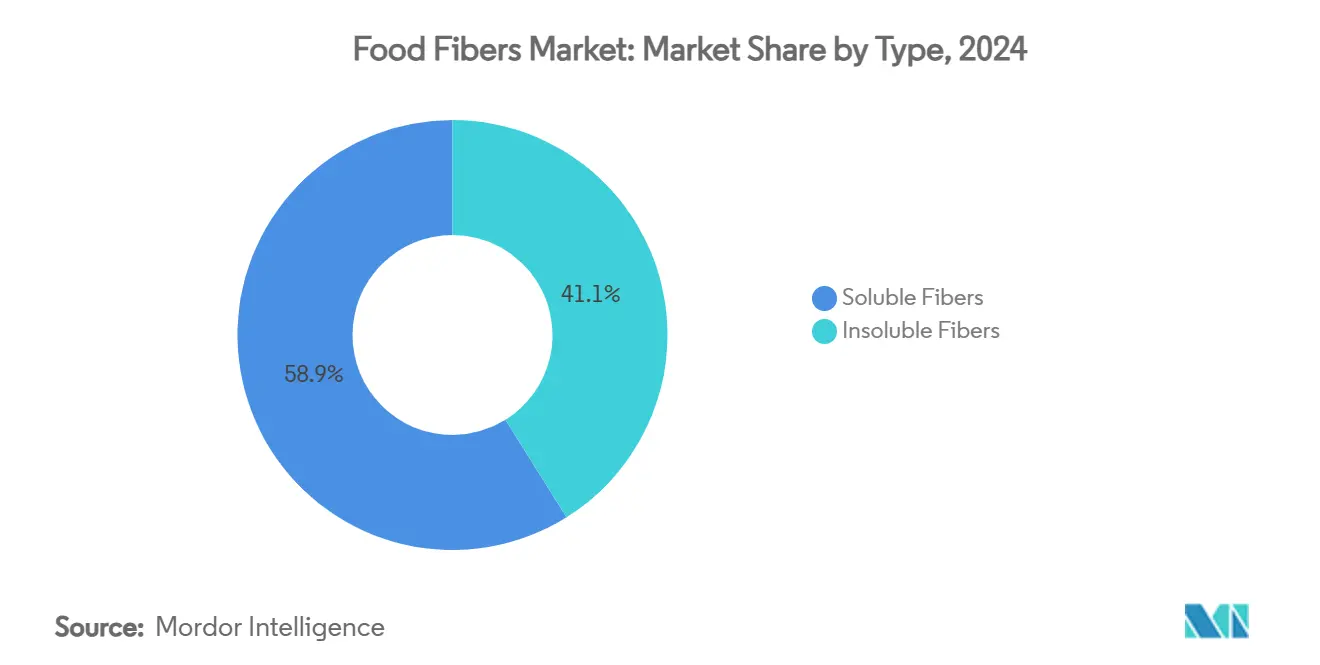
By Source: Cereals Dominate While Nuts and Seeds Surge
Cereals and grains dominated the food fibers market with a 48.15% share in 2024, primarily due to their well-established milling infrastructure and efficient supply chain networks. The widespread availability of wheat, oat, and corn co-products has made these sources particularly attractive for fiber extraction. Oat-derived beta-glucan has gained significant traction by meeting stringent viscosity standards for heart-health claims, while corn hull fibers have found success in fiber-enriched tortilla production, especially in Hispanic markets. The ability to procure these materials at commodity scale has made them ideal for large CPG manufacturers seeking consistent production volumes, further supported by extensive human-health research documentation that expedites regulatory approvals across various jurisdictions.
The nuts and seeds segment has emerged as the most dynamic category in the food fibers market, projecting an 11.80% CAGR through 2030. This growth is largely attributed to increasing consumer demand for transparent ingredient sourcing and nutrient-dense food options. Chia and flax hulls have become particularly valuable in this segment, offering a unique combination of alpha-linolenic acid and dietary fiber. This dual functionality allows manufacturers to develop products with both omega-3 and gut-health benefits, meeting the growing consumer preference for multi-functional food ingredients that deliver comprehensive nutritional benefits.
By Form: Powder Leads While Liquid Formulations Accelerate
In 2024, the powder segment commands a dominant 51.12% market share, owing to its established manufacturing processes, extended shelf life, and versatility across various applications. Manufacturers can seamlessly incorporate fibers into dry mix products, baked goods, cereals, and supplement formulations using powder formats, all without significant process adjustments. This segment's compatibility with existing production lines, coupled with low transportation costs, bolsters its leading position. The maturity of spray-drying, roller drying, and agglomeration techniques has enabled efficient bulk production and consistent quality, making powders the dominant format in the food fiber industry.
Liquid and syrup formulations are witnessing a robust growth rate of 12.05% CAGR, fueled by a surge in demand for beverage fortification and a growing consumer inclination towards ready-to-consume products. This growth is especially pronounced in functional and sports drinks, where liquid fibers integrate smoothly, maintaining both mouthfeel and stability. Furthermore, manufacturers are venturing into integrating liquid fibers in dairy alternatives, fruit concentrates, and nutrition products for children, tapping into the trends of convenience and broader consumption occasions.
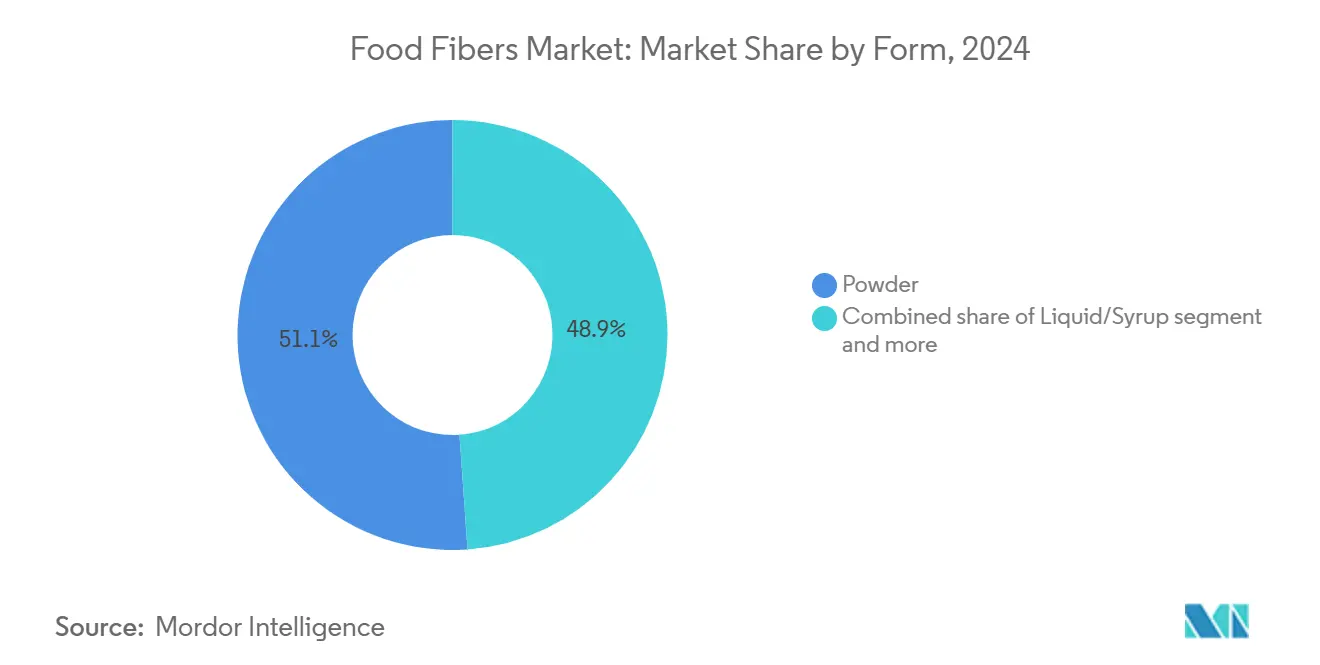
Note: Segment shares of all individual segments available upon report purchase
By Application: Food and Beverage Dominates While Supplements Accelerate
Food and beverage applications account for 47.37% of market share in 2024, demonstrating widespread fiber fortification across product categories. Bakery and confectionery segments lead this category, as fibers integrate effectively with traditional baking processes and consumers readily accept fiber-enriched baked goods. Dairy and frozen desserts utilize fiber to enhance texture and reduce sugar content while maintaining product appeal. The beverage segment shows significant growth as manufacturers incorporate prebiotic fibers at therapeutic levels without affecting taste or visual appeal.
The dietary supplements segment is projected to grow at 12.64% CAGR through 2030, driven by consumer demand for targeted nutritional products and the ability to deliver concentrated fiber doses. This growth stems from consumers' increased understanding of specific fiber types and their health benefits, shifting from general fiber supplements to specialized products for digestive health, weight management, and metabolic support. The pharmaceutical sector maintains consistent demand for fiber in medical nutrition products, while animal nutrition and pet food markets expand due to increased recognition of fiber's importance in animal health.
Geography Analysis
North America maintains market leadership with 41.24% share in 2024, supported by advanced regulatory frameworks that facilitate health claim substantiation and established consumer awareness of fiber's health benefits. The FDA's progressive approach to dietary fiber definition, including the recognition of additional non-digestible carbohydrates, provides manufacturers with clear pathways for product development and marketing U.S. Food and Drug Administration. The region benefits from sophisticated supply chain infrastructure and established relationships between ingredient suppliers and food manufacturers that facilitate rapid product innovation and market introduction.
Asia-Pacific demonstrates the highest growth potential at 10.79% CAGR, driven by government health initiatives and rising disposable incomes that enable premium product adoption. China's Food and Nutrition Development Guideline (2025-2030) specifically targets increased fiber intake to 25-30 grams daily, creating unprecedented demand for fiber-fortified products. The region's growth is further supported by increasing urbanization, changing dietary patterns, and growing awareness of Western nutritional concepts among middle-class consumers.
Europe maintains steady growth supported by stringent regulatory standards that enhance consumer confidence in functional food products. The European Food Safety Authority's comprehensive health claims evaluation process, while creating barriers to entry, ultimately supports market development by ensuring product efficacy and safety European Food Safety Authority [4]Source: European Food Safety Authority, “Health Claims Assessment,” efsa.europa.eu. South America and the Middle East & Africa represent emerging opportunities, with Brazil's advanced biofuel research capabilities potentially creating new fiber extraction technologies and the GCC region's growing health consciousness driving demand for functional ingredients
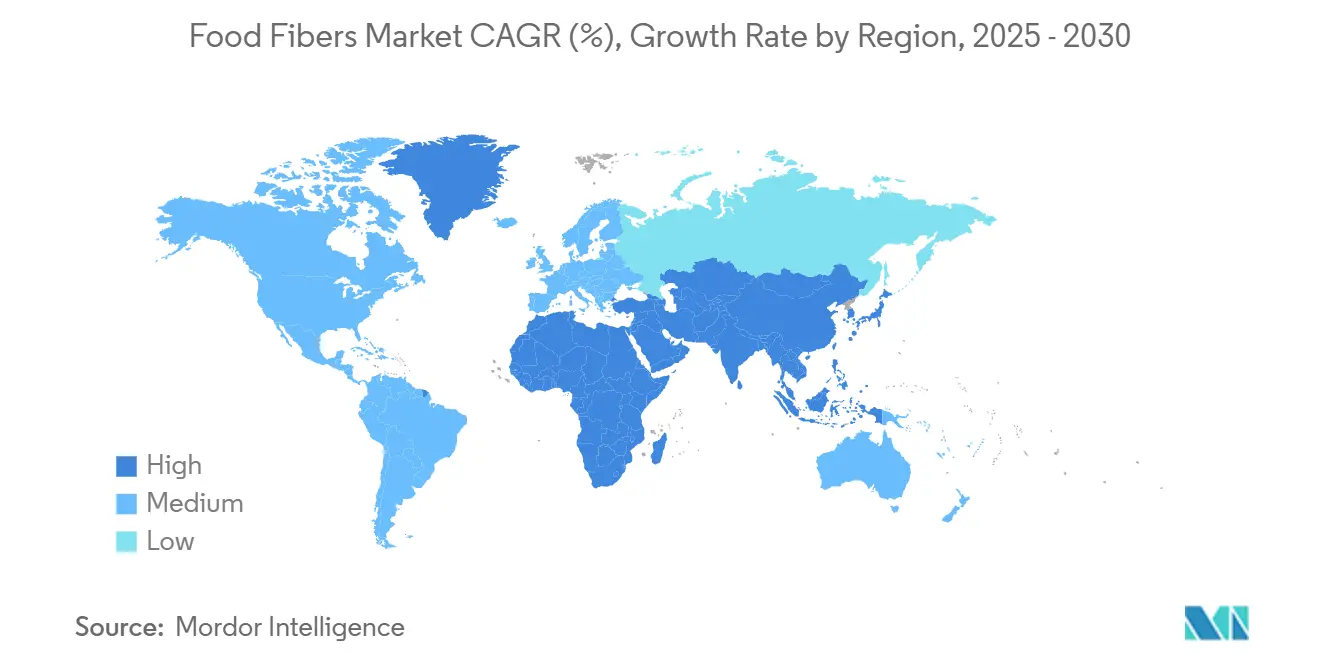
Competitive Landscape
The food fibers market shows fragmentation, with multinational corporations holding substantial market shares through vertical integration and research capabilities. Companies like Cargill, ADM, and Ingredion maintain competitive advantages through their agricultural expertise and processing infrastructure, while developing specialized fiber extraction technologies. The market competition has intensified as companies expand through strategic acquisitions, as evidenced by recent industry consolidation activities that strengthen portfolios in nature-based ingredients, including pectin and citrus fibers.
Technology investment has emerged as a competitive differentiator, with companies focusing on advanced extraction methods and sustainable processing. Major industry players continue to make substantial capital investments in their facilities, reflecting the resources required for technological advancement in texture solutions and clean-label ingredients. These investments demonstrate the industry's commitment to innovation and process optimization to meet evolving market demands.
The market presents significant opportunities in specialized segments such as animal nutrition, sustainable packaging materials, and personalized nutrition solutions. In these areas, smaller companies can establish strong market positions by targeting niche markets and developing innovative applications rather than competing in commodity fiber production. This strategic approach allows newer entrants to differentiate themselves and capture value in specific market segments while avoiding direct competition with established players in bulk production.
Food Fibers Industry Leaders
-
Ingredion Incorporated
-
Cargill, Incorporated
-
Tate & Lyle PLC
-
Archer Daniels Midland Company
-
Roquette Frères SA
- *Disclaimer: Major Players sorted in no particular order
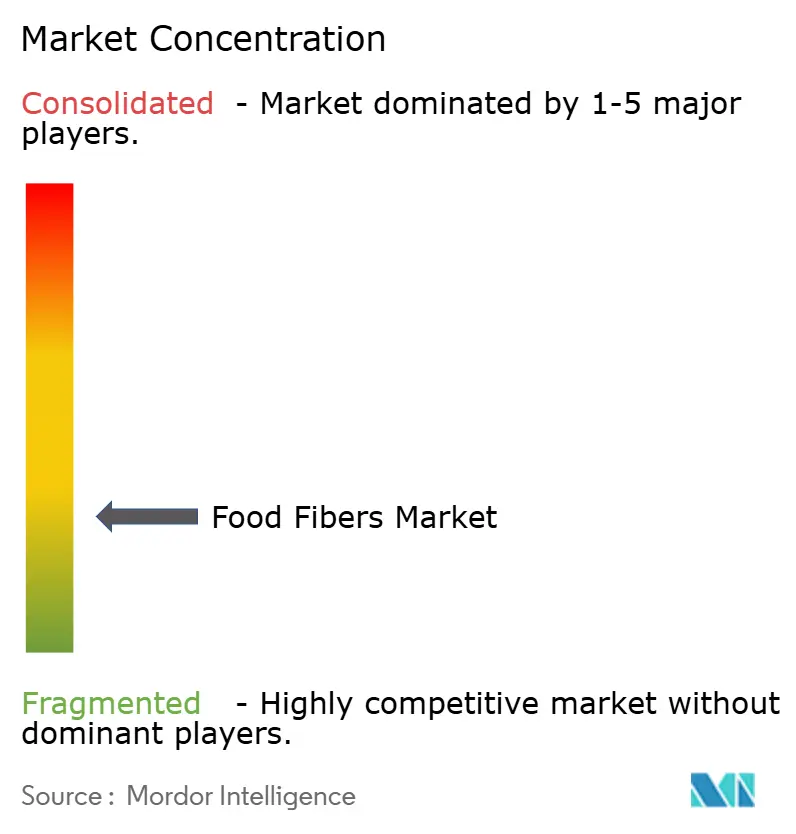
Recent Industry Developments
- February 2025: Layn launched Galacan, a beta-glucan product manufactured through precision fermentation at its biotech facility. The product offers improved functionality for supplements, foods, and beauty products.
- November 2024: Tate & Lyle completed its acquisition of CP Kelco, creating a leading global specialty food and beverage solutions business. The combination enhances Tate & Lyle's portfolio with nature-based ingredients including pectin and citrus fibers, strengthening their position in clean-label and functional ingredient markets
- June 2024: Cargill Incorporation established a technology hub in Atlanta, Georgia, to focus on digital transformation in food and agriculture. The facility develops digital solutions to improve global food supply chain efficiency and sustainability, which affects fiber ingredient sourcing and distribution.
Global Food Fibers Market Report Scope
Food fiber, also known as dietary fiber, is a group of compounds found in plants that cannot be fully digested in the human gut. Commercially, fibers are derived from fruits and vegetables and can be isolated or modified after processing. The food fibers market is segmented into type, application, and geography. By type, the market is segmented into soluble and insoluble fibers. The soluble fibers segment is further divided into inulin, pectin, polydextrose, beta-glucan, and other soluble fibers. The insoluble fibers are segmented into cellulose, lignin, hemicellulose, chitin and chitosan, resistant starch, and other insoluble fibers. Based on application, the market is segmented into food and beverages, dietary supplements, and pharmaceuticals.
Further, based on food and beverage application, the market is segmented into bakery and confectionery, dairy, meat, poultry and seafood, beverages, and other food and beverage products. By geography, the report analyses the major economies of North America, Europe, Asia-Pacific, South America, the Middle East & Africa. For each segment, the market sizing and forecasts have been done based on value (in USD million).
| Soluble Fibers | Inulin |
| Pectin | |
| Polydextrose | |
| Beta-glucan | |
| Arabinoxylan | |
| Resistant Maltodextrin | |
| Other Soluble Fibers | |
| Insoluble Fibers | Cellulose |
| Hemicellulose | |
| Lignin | |
| Chitin and Chitosan | |
| Resistant Starch | |
| Other Insoluble Fibers |
| Cereals and Grains |
| Fruits and Vegetables |
| Nuts and Seeds |
| Other Sources |
| Powder |
| Liquid/Syrup |
| Other Forms |
| Food and Beverage | Bakery and Confectionery |
| Dairy and Frozen Desserts | |
| Meat, Poultry and Seafood | |
| Beverages | |
| Other Food and Beverages | |
| Dietary Supplements | |
| Pharmaceuticals | |
| Animal Nutrition and Pet Food | |
| Other Applications |
| North America | United States |
| Canada | |
| Mexico | |
| Rest of North America | |
| Europe | Germany |
| United Kingdom | |
| Italy | |
| France | |
| Spain | |
| Netherlands | |
| Rest of Europe | |
| Asia-Pacific | China |
| India | |
| Japan | |
| Australia | |
| South Korea | |
| Rest of Asia-Pacific | |
| South America | Brazil |
| Argentina | |
| Rest of South America | |
| Middle East and Africa | South Africa |
| Saudi Arabia | |
| United Arab Emirates | |
| Rest of Middle East and Africa |
| By Type | Soluble Fibers | Inulin |
| Pectin | ||
| Polydextrose | ||
| Beta-glucan | ||
| Arabinoxylan | ||
| Resistant Maltodextrin | ||
| Other Soluble Fibers | ||
| Insoluble Fibers | Cellulose | |
| Hemicellulose | ||
| Lignin | ||
| Chitin and Chitosan | ||
| Resistant Starch | ||
| Other Insoluble Fibers | ||
| By Source | Cereals and Grains | |
| Fruits and Vegetables | ||
| Nuts and Seeds | ||
| Other Sources | ||
| By Form | Powder | |
| Liquid/Syrup | ||
| Other Forms | ||
| By Application | Food and Beverage | Bakery and Confectionery |
| Dairy and Frozen Desserts | ||
| Meat, Poultry and Seafood | ||
| Beverages | ||
| Other Food and Beverages | ||
| Dietary Supplements | ||
| Pharmaceuticals | ||
| Animal Nutrition and Pet Food | ||
| Other Applications | ||
| By Geography | North America | United States |
| Canada | ||
| Mexico | ||
| Rest of North America | ||
| Europe | Germany | |
| United Kingdom | ||
| Italy | ||
| France | ||
| Spain | ||
| Netherlands | ||
| Rest of Europe | ||
| Asia-Pacific | China | |
| India | ||
| Japan | ||
| Australia | ||
| South Korea | ||
| Rest of Asia-Pacific | ||
| South America | Brazil | |
| Argentina | ||
| Rest of South America | ||
| Middle East and Africa | South Africa | |
| Saudi Arabia | ||
| United Arab Emirates | ||
| Rest of Middle East and Africa | ||
Key Questions Answered in the Report
What is the current size of the food fibers market?
The market stands at USD 9.16 billion in 2025 and is projected to reach USD 14.59 billion by 2030.
Which segment contributes most to revenue?
Soluble fibers lead, accounting for 58.95% of revenue in 2024 due to versatile functional and health-claim properties.
Which region is growing fastest?
Asia-Pacific is expanding at a 10.79% CAGR, propelled by government fiber-intake targets and rising disposable incomes.
Why are liquid fiber formats gaining popularity?
Liquid or syrup formulations integrate smoothly into functional beverages, enabling clear, ready-to-drink products without texture issues and are forecast to grow at 12.05% CAGR.
Page last updated on:
